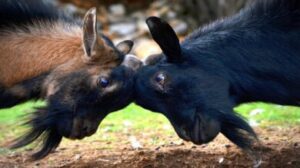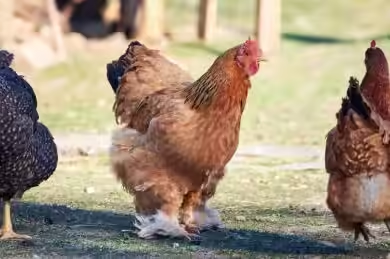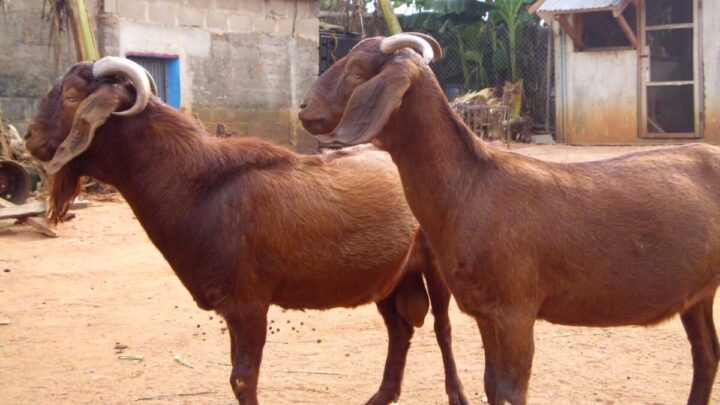Last updated on August 15, 2025
If you want to start a profitable goat farming business in Nigeria, choosing the right breed is crucial. Not all goats are created equal—some grow faster, produce more milk, or offer better meat quality than others.
Choosing the right breed is key to success. But first, you must decide if goats are the right animal for you. We break down the full profitability of goats compared to sheep in our comprehensive guide.
So, which ones should you invest in? Here are the top ten(10) goat breeds that can help you maximize profits.
1. Kalahari Red Goat
This South African meat goat thrives in Nigeria’s hot climate and is highly profitable for commercial farmers.
Characteristics:
- Reddish-brown coat, large muscular body.
- Strong legs and high heat tolerance.
- Weighs 60-90 kg (132-198 lbs) at maturity.
Advantages:
- Fast growth rate, reaching market size quickly.
- Excellent resistance to diseases and parasites.
- High-quality, lean meat that sells for a premium price.
Best For:
Farmers looking for a low-maintenance, high-yield meat goat.
2. Boer Goat
One of the fastest-growing meat goats, Boer goats are popular worldwide for their large body size and quick weight gain.
Characteristics:
- White body with a brown or red head.
- Stocky, muscular build.
- Weighs 70-120 kg (154-264 lbs) at maturity.
Advantages:
- Can reach market weight in just 6 months.
- High fertility rate, with most does giving birth to twins.
- Requires less feed per weight gain compared to other breeds.
Best For:
Farmers who want to maximize profit with fast-growing meat goats.
3. West African Dwarf (WAD) Goat
The most common goat breed in Nigeria, known for its hardiness and adaptability.
Characteristics:
- Short, compact body with various coat colors.
- Weighs 20-30 kg (44-66 lbs) at maturity.
- Highly resistant to local diseases.
Advantages:
- Can thrive in harsh and humid environments.
- Low maintenance, making it ideal for small-scale farmers.
- High fertility, with does giving birth 2-3 times a year.
Best For:
Farmers in humid regions looking for disease-resistant goats.
4. Red Sokoto (Maradi) Goat
Nigeria’s most popular meat goat, also valued for its premium leather.
Characteristics:
- Deep red to brown coat color.
- Medium-sized with a compact body.
- Weighs 20-40 kg (44-88 lbs) at maturity.
Advantages:
- Fast growth rate, ideal for meat production.
- High fertility, with most does giving birth to twins.
- Resistant to local diseases, reducing vet costs.
- Produces one of the best-quality leathers in the world.
Best For:
Farmers focused on meat production and leather exports.
5. Sahelian Goat
A tall, long-legged breed that thrives in Nigeria’s dry regions.
Characteristics:
- Light brown, white, or gray coat.
- Long ears and lean body.
- Weighs 25-45 kg (55-99 lbs) at maturity.
Advantages:
- Can survive with minimal water and feed.
- Produces 1-2 liters of milk per day.
- High fertility rate with fast reproduction cycles.
Best For:
Farmers in dry regions looking for milk and meat production.
6. Nigerian Dwarf Goat
A top-quality dairy breed, known for its high-butterfat milk.
Characteristics:
- Small size with short legs and a variety of coat colors.
- Weighs 20-30 kg (44-66 lbs) at maturity.
- Friendly and easy to manage.
Advantages:
- Produces 1-2 liters of high-butterfat milk daily.
- High fertility rate, often giving birth to twins or triplets.
- Perfect for small-scale dairy farms.
Best For:
Farmers interested in goat milk production.
7. Alpine Goat
A high-yield dairy goat that produces large quantities of milk.
Characteristics:
- Medium to large size with various coat colors.
- Weighs 50-80 kg (110-176 lbs) at maturity.
- Long lactation period.
Advantages:
- Produces up to 1-2 gallons of milk per day.
- Adapts well to different environments.
- Requires minimal veterinary care.
Best For:
Farmers planning large-scale dairy goat farming.
8. Damascus Goat
A dual-purpose breed known for its high-quality meat and milk.
Characteristics:
- Large body with a distinct long face and drooping ears.
- Weighs 60-90 kg (132-198 lbs) at maturity.
- Thick reddish-brown or black coat.
Advantages:
- High meat yield, making it a great choice for commercial farming.
- Produces 1-2 liters of milk per day.
- High fertility rate, with frequent twin births.
Best For:
Farmers looking for both meat and milk production.
9. Beetal Goat
A large dual-purpose goat breed, ideal for both meat and milk farming.
Characteristics:
- Large frame with long ears and a shiny coat.
- Weighs 50-90 kg (110-198 lbs) at maturity.
- Strong and adaptable.
Advantages:
- Produces 1.5-2 liters of milk per day.
- Large body for high meat yield.
- High fertility, often giving birth to twins.
Best For:
Farmers who want good milk production along with meat sales.
10. Pygmy Goat
A small but productive breed, perfect for limited-space farming.
Characteristics:
- Compact, muscular body with a variety of coat colors.
- Weighs 15-30 kg (33-66 lbs) at maturity.
- Hardy and disease-resistant.
Advantages:
- Requires less feed and space.
- Fast growth rate with good-quality meat.
- Low maintenance, making it great for beginners.
Best For:
Farmers with small land space looking for low-cost goat farming.
Which Goat Breed Should You Choose?
Your choice depends on your farming goals:
- For meat production: Red Sokoto, Boer, and Kalahari Red goats are the best.
- For milk production: Sahelian goats are ideal.
- If you want low-maintenance farming: West African Dwarf goats require less feed and care.
- For large-scale commercial farming: Boer and Kalahari Red goats offer the highest profitability.
Final Thoughts
Selecting the right goat breed can make or break your farming business. If you’re just starting out, go for breeds that require low maintenance, like West African Dwarf or Red Sokoto. But if you’re aiming for high commercial returns, consider investing in Boer or Kalahari Red goats.
Want to learn more about profitable goat farming? Check out our detailed guide on starting a goat farm in Nigeria!


